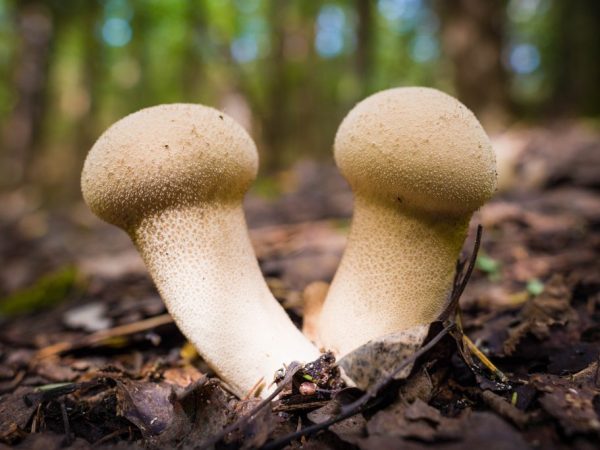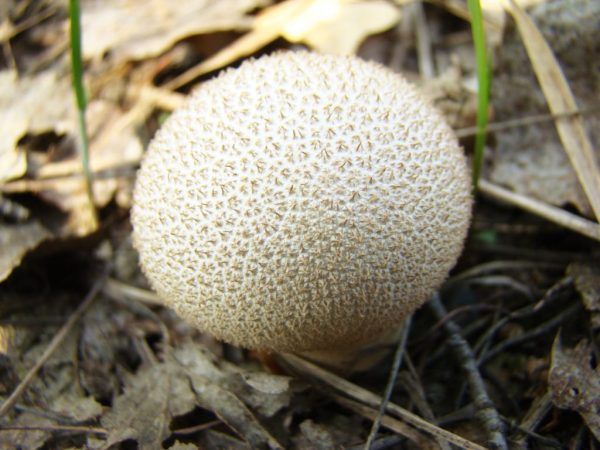Characteristics and application of the raincoat mushroom
The raincoat mushroom grows both in city parks, gardens and fields, and in forests. A white mushroom with a spherical "cap" attracts the attention of children. If you kick him or hit him with a stick, a reddish or greenish cloud flies out from within. This species is notable not only for its funny, but also useful properties and excellent taste.

Characteristics and application of the raincoat mushroom
Characteristic
These mushrooms belong to the Champignon family. They are distinguished into a separate genus, which includes a wide species diversity.
Irina Selyutina (Biologist):
Raincoats belong to gasteromycete fungi and are part of various ecological groups, depending on the conditions in which they live. So, for example, some of them include a group lignophilic gasteromycetes - i.e. settling on plant debris: dead wood, dead wood. These are typical forest dwellers. They are mesophiles: for their development, a significant, more or less constant amount of moisture is required, for example, a pear-shaped raincoat, etc. Another part of the species belongs to the group soil forest gasteromycetes-saprophytes, which live on the soil under the forest canopy and in terms of their growth and development conditions are close to the corresponding group of agaric (cap) fungi. They are hygrophilous species. This group includes, for example, a thorny raincoat, an umber raincoat, a soft raincoat, etc.
All of its representatives are characterized by a rounded or pear-shaped shape of the fruiting body. This type of mushroom is not the same as the others: it does not have a clearly defined cap, but it has a false stem, which smoothly passes into a rounded upper part.
The pulp of raincoats is fleshy, dense, depending on age, it has a different color. In young specimens, it is white, in adults it becomes olive or dark yellow. The darker the mushroom, the older it is and, accordingly, from the point of view of cooking, it is less tasty (everything is like mushrooms we are used to).
The fruiting bodies of raincoats are formed on dense mycelial cords.
Edible species
All varieties of a raincoat differ from each other in the place of growth, shape and color. Regardless of the species, they appear at the same time: from mid-summer to the end of October. All varieties are edible and tasty as long as their flesh is white.
Meadow raincoat
Pear-shaped in the shape of the fruiting body, the meadow is edible. It grows mainly along roads and in clearings. The sizes are usually small: about 3-4 cm in diameter. The fruit body is snow-white, narrowed downwards. With age, meadow raincoats darken and acquire an olive color on the surface. Their snow-white pulp with a delicate taste gradually becomes tough and unsuitable for food.
Pearl raincoat
A pearly raincoat, or prickly, or real, has a thick "leg" and a spherical surface covered with numerous thorns (needles). This is the reason why it is called spiny. At the slightest touch to its surface, the raincoat loses its "thorns". Adult specimens reach a height of 10 cm. By the way. The lower part is sterile, i.e. in it, the formation of disputes does not occur.
Thorny raincoats grow on forest edges, in forests well-lit by the sun.
Delicious dishes and snacks are made from these mushrooms: they are salted, pickled, boiled.
Umber raincoat
The brown raincoat, or umber, got its name from the color of the body surface. It grows practically "sitting" on the ground, because its "leg" is very short. This species is small in size: its diameter is no more than 5 cm. From above it is covered with dark brown peculiar thorns, with which it is almost impossible to damage your skin.
It is easy to distinguish this raincoat by the patterned patterns that form the needles. Often, these patterns resemble the shape of a star. The brown raincoat is edible; it is readily used in cooking for the preparation of aromatic and savory dishes. Its flesh is white in young specimens, it darkens with age to a purple-brown color.
Giant raincoat
This is a huge mushroom, which is also called Langermannia gigantea, or giant bighead, reaches large sizes: 30-40 cm in diameter of the fruiting body. The giant raincoat has no legs, it has a spherical shape and is snow-white in color. Its outer layer of the shell, exoperidium, quickly collapses and disappears. Edoperidium, although brittle, is rather thick. When it also breaks down in a mature mushroom, you can see a cotton-like pulp.
The giant raincoat mushroom is one of the rarest, so it is difficult to find it in regions with a temperate climate. The giant raincoat grows in old pastures, meadows or clearings, less often it can be found in deciduous forests.
All mushrooms - hedgehog raincoats, meadow, giant - have not only excellent taste, but also medicinal properties.
Medical use

Mushrooms have medicinal properties
Both traditional healers and representatives of traditional (official) medicine speak about the medicinal properties of the raincoat mushroom. The pulp of fruit bodies, which contains many useful components, has a beneficial effect on health.
The healing properties of raincoats are as follows:
- It is an excellent antiseptic and sorbent. It cleanses the body of harmful substances and toxins.
- Folk remedies prepared on its basis (tincture, decoction) help cleanse the liver and intestines.
- Normalizes blood circulation and improves blood composition.
- It removes radionuclides from the body, thereby preventing the development of cancer problems.
- The pulp has a good wound healing effect, it is applied to fresh wounds to stop bleeding. Also, a raincoat is good for burns. The pulp is broken in half and applied to the affected area.
- Treats skin diseases: folk remedies prepared on the basis of fruit bodies promote tissue regeneration with boils, urticaria.
- The medicinal properties of decoctions were appreciated by many patients in the treatment of bronchitis, pneumonia and even tuberculosis. According to traditional healers, such a broth is not inferior to chicken broth in terms of the composition of nutrients.
- The giant raincoat is used for the prevention of cancer, since it contains calvacin. Also, the giant raincoat treats indigestion: diarrhea, diarrhea, bloating.
- Folk remedies based on raincoats normalize blood pressure, the work of the gastrointestinal tract.
- Tincture based on a raincoat is taken for angina pectoris, diseases of the bladder.
- The great benefits of the tincture are noted by many with a breakdown, general malaise.With its regular use, appetite, tone increase, a person feels a surge of energy.
False mushrooms, or false raincoats
In appearance, the false mushroom raincoat looks like a real one. On the territory of Russia, the most popular species are common pseudo-raincoat and L. warty.
Irina Selyutina (Biologist):
To make sure your basket contains raincoats and not boat rains, pay attention to:
- Peridium (shell): in false raincoats it is dense and leathery (in mature specimens, in young ones it is smooth), while in real raincoats it is thin.
- Number of layers of peridium: pseudo-raincoats have one (very rarely two), real raincoats always have two (exo- and endoperidia).
- Spore weight: even in a mature state forms a single whole, i.e. dense, while in raincoats it is loose and soft.
- Capillity: filamentous filaments that facilitate loosening of the spore mass in pseudo-raincoats are absent.
- False leg: in false raincoats is absent.
By the way. Very often, until ripening, pseudo-raincoats remain submerged in the soil, as a result of which they are confused with truffles.
These are inedible, poisonous mushrooms, which, when consumed, cause weakness, malaise. If they are eaten in large quantities, severe intoxication occurs: allergies (rash, itching or redness), conjunctivitis, runny nose, rarely - nausea and vomiting. These mushrooms do not pose a threat to human life.
Common pseudo-raincoat
Description of this species:
- mushroom yellow, nondescript in appearance, height up to 12 cm;
- the spherical surface is covered with a large number of scales, warts and cracks;
- this species has no legs.
This false raincoat mushroom grows mainly in dry places: in meadows, along paths, in coniferous and deciduous forests well-lit by the sun. Its range is the North Caucasus, the Far East, and Eastern Europe. The mushroom bears fruit from July to October.
Warty pseudo-raincoat

The color of the mushroom changes with age
Tuberous or pear-shaped mushrooms of pseudo-raincoats differ from the first species by the presence of a small "leg" about 1.5 cm long. Sometimes there are also higher specimens with a "leg" up to 6-7 cm. These are poisonous mushrooms.
Depending on the age, the body color varies from light gray to dark brown. Old mushrooms have black flesh. The surface is usually warty.
This type of fungus has adapted to grow in different climatic conditions. The fruiting period is late summer-mid-October.
The warty pseudo-raincoat grows in gardens, on the edges, next to deciduous trees: birch, oak.
Healing recipes
The most popular and effective drug in the treatment of many ailments is a tincture based on a raincoat mushroom.
Recipe number 1
Crushed spore powder is taken in 1 tsp with a glass of water. You need to drink the medicine once a day, at night. The treatment is carried out for 2 months. The tool helps with poisoning, diseases of the gastrointestinal tract.
With inflammation of the lymph nodes and sarcoidosis (an inflammatory disease that can affect many organs and systems of a person with the formation of granulomas), take the same dose, only 2 times a day until complete recovery.
Recipe number 2
To prepare the tincture, you will need 500 g of vodka and 100 g of spore powder. The resulting mixture is tightly covered with a lid, placed in a cool dark place for 2 weeks. Then they filter and drink 2 tsp each. before breakfast, lunch and dinner (30 minutes before meals). Treatment lasts a month with a week break.
Recipe 3
This medicine helps with cancer. You need to pour 200 g of spore powder into 1.5 liters of vodka (moonshine). The mixture is then poured into a jar, which is buried in the ground to a depth of 40 cm. After 3 weeks, it is dug out, filtered without shaking and drunk on an empty stomach, 15 g 3 times a day.
To get rid of kidney stones, you need to eat bread sprinkled with raincoat spores.
How to collect and procure
For eating, it is worth collecting young mushrooms with white pulp, but for the preparation of medicinal preparations, if spore powder is indicated, more mature mushrooms are needed.
Such a product is harvested for the winter in different ways:
- dried in pieces or whole;
- pickled or salted;
- frozen in the freezer followed by slices; small fruits are frozen whole.
In any form, the product does not lose its taste and useful qualities.
Advice. If you decide to collect raincoats, do it in dry, sunny weather, otherwise your harvest by the time you return home will turn into something resembling dirty rags, which you can no longer eat.
Conclusion
Thanks to its beneficial properties and excellent taste, the raincoat mushroom is in great demand among consumers. Delicious dishes and snacks are prepared from it, and it is also used for the prevention and treatment of various diseases. When going on a "quiet hunt" for these mushrooms, you should familiarize yourself with the features of real raincoats so as not to confuse them with false species.



